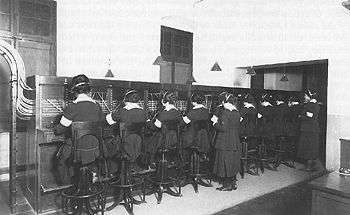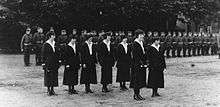Hello Girls

Hello Girls was the colloquial name for American female switchboard operators in World War I, formally known as the Signal Corps Female Telephone Operators Unit. During World War I, these switchboard operators were sworn into the U.S. Army Signal Corps.[1]
This corps were formed in 1917 from a call by General John J. Pershing to improve communications on the Western front. Applicants had to be bilingual in English and French. Over 7,000 women applied, but only 450 were accepted. Many were former switchboard operators or employees at telecommunications companies.[1] They completed their Signal Corps training at Camp Franklin, now a part of Fort George G. Meade in Maryland.
History
Much earlier (than WW1) published references to "Hello Girls" exist. The term was first coined for the female telephone switchboard operators in the US. The earliest reference is in Mark Twain's A Connecticut Yankee in King Arthur's Court written in 1889.[2] Although the term may have been applied to the signalling corps, it did not originate there but was rather the common term used for the ladies who would say hello when you rang the switch as opposed to direct calling.
Service
After training, the first operators, under the lead of Chief Operator Grace Banker, left for Europe in March 1918. Members of this unit were soon operating telephones in many exchanges of the American Expeditionary Forces in Paris, Chaumont, and seventy-five other French locations as well as British locations in London, Southampton, and Winchester.[3] The Chief Operator of the Second American Unit of Telephone Operators was Inez Crittenden of California.[4]


Recognition
Despite the fact that they wore U.S. Army Uniforms and were subject to Army Regulations (Chief Operator Grace Banker received the Distinguished Service Medal),[5] they were not given honorable discharges but were considered "civilians" employed by the military, because Army Regulations specified the male gender. Not until 1978, the 60th anniversary of the end of World War I, did Congress approve Veteran Status/Honorable discharges for the remaining "Hello Girls." A Hello Girl uniform is on display at the U.S. Army Signal Museum. The uniform was worn by Louise Ruffe, a U.S. Signal Corps telephone operator.[6] In 2018, the "Hello Girls Congressional Gold Medal Act" was pending final approvals.[7]
References
| Wikimedia Commons has media related to Signal Corps Female Telephone Operators Unit. |
- 1 2 Malmstrom Airforce Base Archived 2011-07-22 at the Wayback Machine.
- ↑ The direct quote is "The humblest hello-girl along ten thousand miles of wire could teach gentleness, patience, modesty, manners, to the highest duchess in Arthur's land"
- ↑ Getting the Message Through: A Branch History of the U.S. Army Signal Corps by Rebecca Robbins Raines pg 169, available online at
- ↑ Pauline Hess, "Interesting Westerners", Sunset Monthly (June 1918): 47-48.
- ↑ Sterling, Christopher H. (2008). Military Communications: From Ancient Times to the 21st Century. ABC-CLIO., p.55, ISBN 978-1-85109-732-6.
- ↑ "Hello Girls". U.S. Army Signal Museum. Archived from the original on 2012-03-24. Retrieved 2010-01-23.
- ↑ "Hello Girls Congressional Gold Medal" (PDF). United States Senate. Retrieved 26 August 2018.
Further reading
- Cobbs, Elizabeth (2017). The Hello Girls: America’s First Women Soldiers. Harvard University Press. ISBN 0674971477.
- Yockelson, Mitchell, Forty-Seven Days: How Pershing's Warriors Came Of Age to Defeat The Germany Army In World War I, New American Library